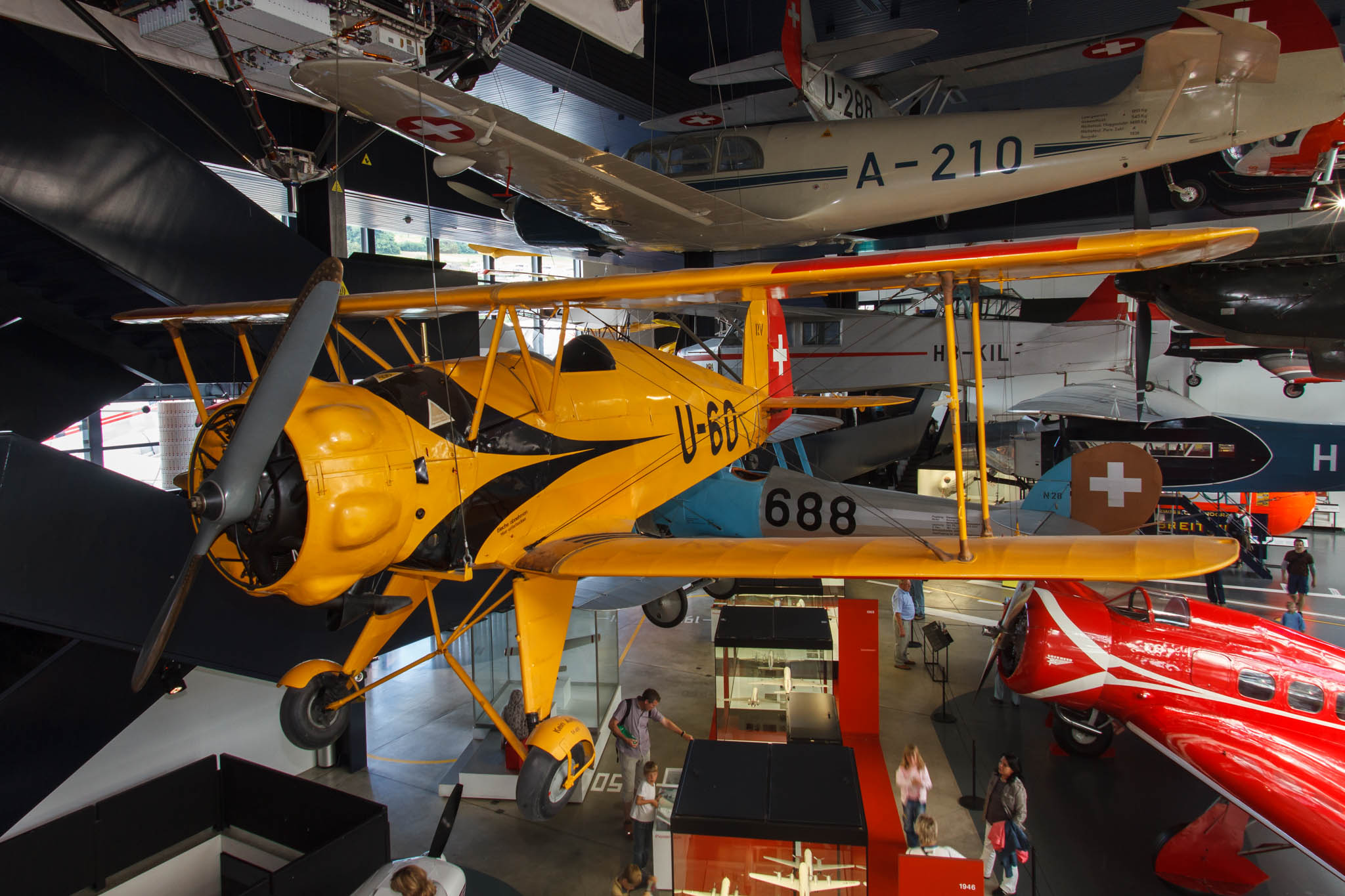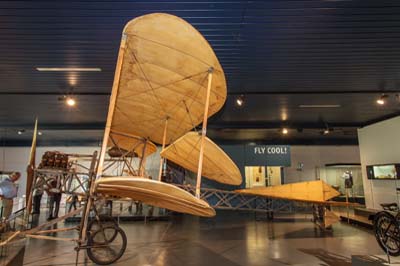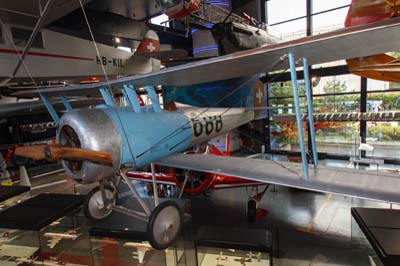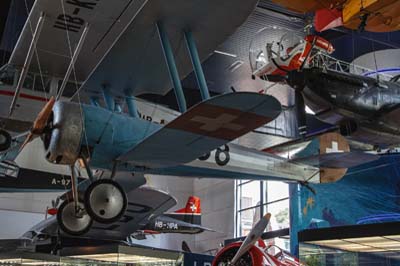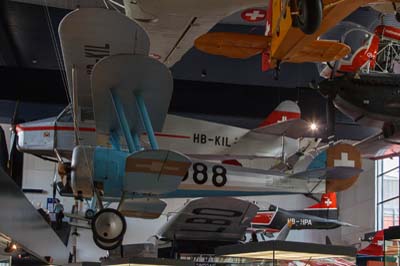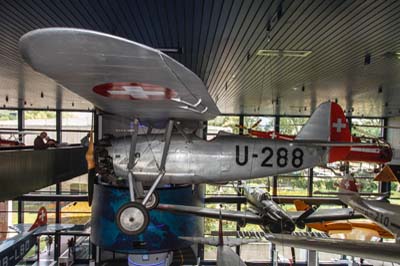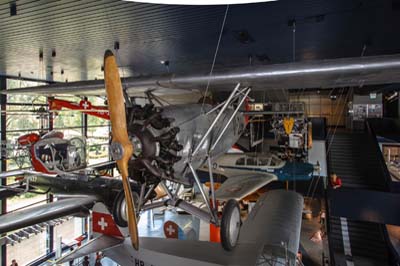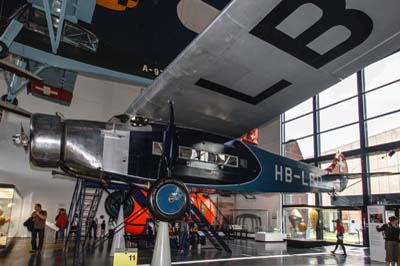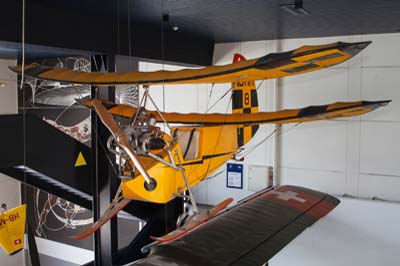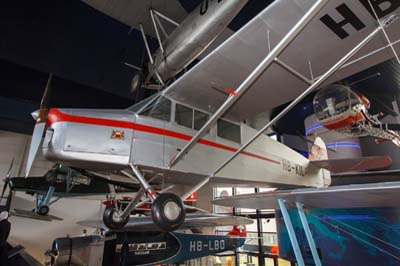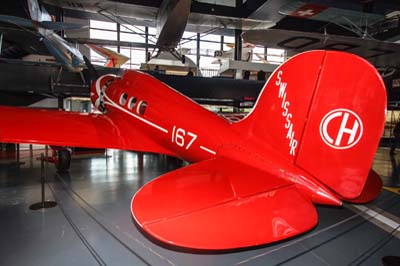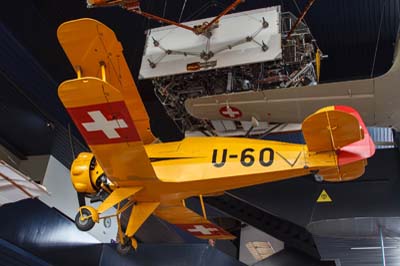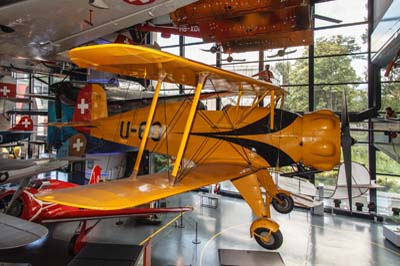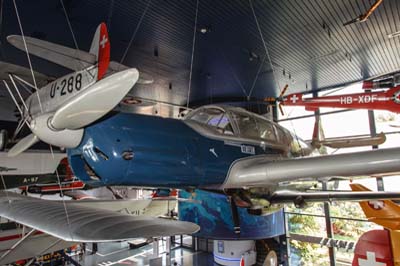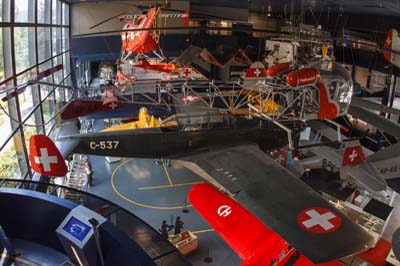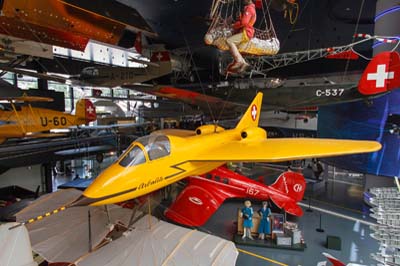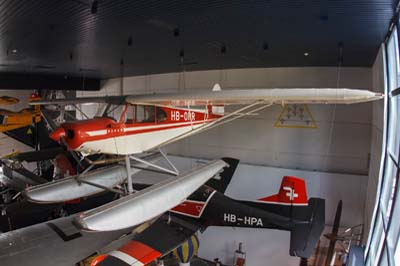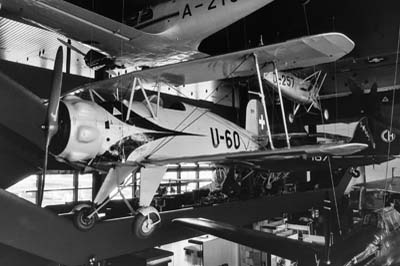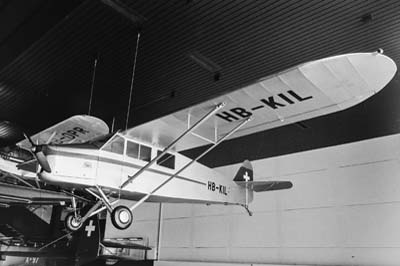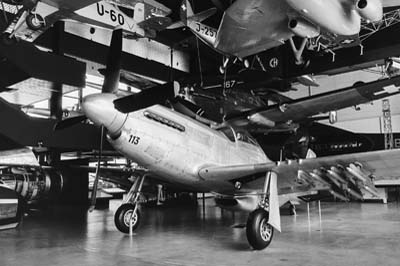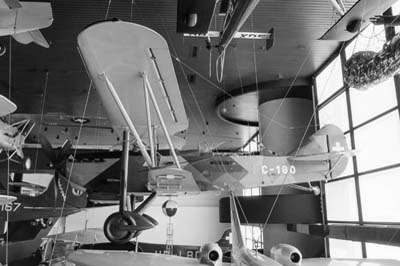Verkehrshaus der Schweiz
(Swiss Museum of Transport)
Lucerne, Switzerland
July 1982 and June 2011
|
The transport museum was originally built in 1957, over the subsequent decades it has been expanded considerably. The last major construction was completed in 1997 making it a very large modern complex covering all elements of transport.
The aircraft hall is filled to the roof with many interesting exhibits, with walkways at a number of levels. For the photographer it is very difficult to get clear angles of each aircraft and images look very cluttered. |
| Bücker Bü133c Jungmeister (U-60) with most of the museum's collection of aircraft in the bckground. |
Left to right: Dufaux 4 was built in 1910 in Geneva by Henri and Armand Dufaux to demonstrate to the military, it was their fourth design. Armand Dufaux flew the length of Lake Geneva in 56 minutes and 5 seconds on August 28, 1910.
Nieuport 28C.1 (688). The Nieuport was designed in France by Gustave Delage in 1917. It was the first aircraft to see service with an American fighter squadron. At the end of World War One Switzerland received 15 Nieuport 28s. The example on display was flown by an american pilot when it force landed at Solothurn in 1918.
|
Left to right: Dewoitine D.26 (U-288). The first D.26 flew in 1929 later twelve were built by Dewoitine in France for assembly by EKW (Eidgenösschische Konstruktionswerkstätten) in Switzerland. They were operated by the military until 1948 before being sold to civilian flying clubs for use as glider tugs. The last of which was not retired until 1970.
Fokker F.VIIa (HB-LBO) first flew in 1924 and 42 examples were built.Up to ten passengers could be carried in unprecedented luxury. The example on display was one of three delivered to Balair as 'CH-157' it was delivered in 1927. In 1934 it was transferred to Swissair and re-registered 'HB-LBO' and was flown until 1978.
Mignet/Roland Py HM.14 Pou du Ciel 'Flying Flea' (HB-MH8) equipped with skis. The HM.14 was designed in 1934 by Henri Mignet was probably the first home-built to be offered to the public for home construction. Following a number of fatal accidents and the discovery of aerodynamic design errors the French authorities banned it from flying in 1936, the British authorities following suit in 1937. The HM.293 was more streamlined and had a more powerful engine than the original HM.14 and many were sold as home-builds in the 1960s. |
Left to right: Comte AC-4 Gentleman (HB-KIL). The Comte AC-4 Gentleman was designed in 1927 by Swiss company Flugzeugbau A. Comte as a two-seat sport or training aircraft. Swissair operated a single AC-4 Gentleman, mainly between Zurich and Lucerne. The example on display is one of 13 built by Alfred Comte.
Lockheed 9C Orion (DL-2A Altair) ('CH-167'). The Lockheed Orion was the fastest commercial aircraft of its time at more than twice as fast as comparable aircraft. The Orion was the first civil aircraft with retractable undercarriage. 35 Orions were built between 1931 and 1934. The Altair on display was converted to an Orion in 1931 and eventually was put on display in 1950. It was bought by the museum in 1976 where it was restored. It is painted in the Swissair colours applied to their two Orions which they operated between 1932 and 1936.
Bücker Bü133c Jungmeister (U-60) The Bü 133 was built for the Lufwaffe as an advanced trainer it was based on the Bücker Bü 131 Jungmann two-seat basic trainer which first flew in 1935. Six Bü 133 (starting with serial U-51) were purchased from Germany and another 50 were built under licence by Dornier for the Swiss Air Force which operated them until 1968. |
Left to right: Messerschmitt Bf-108B-2 Taifun (A-210). The Messerschmitt Bf 108 Taifun was developed by Bayerische Flugzeugwerke (Bavarian Aircraft Works) in Germany as a sports and touring aircraft. The Bf 108A first flew in 1934, followed by the Bf 108B in 1935. The Swiss Air Force received 18 Bf 108s (serials A-201 to A-218) mostly in 1938/39, although they obtained three during the World War Two. The surviving aircraft were withdrawn from service in 1959.
EKW (Eidgenösschische Konstruktionswerkstätten) C-3603-1 (C-537). The EKW C-36 was a multi-purpose fighter-bomber designed in 1939 by the Swiss Federal Constructions Works (EKW). In later life they were used extensively for target towing duties by the Swiss Air Force.
Eidgenössische Flugzeugwerke Emmen N-20 Arbalete is a scale test aircraft.
Piper PA-18 Super Cub 150 (HB-OPR). The Piper PA-18 Super Cub is a two-seat, single-engine monoplane, produced from 1949 for over 40 years by Piper Aircraft, over 9,000 were built. The primary role was bush flying and glider towing, a few were converted to float planes. |
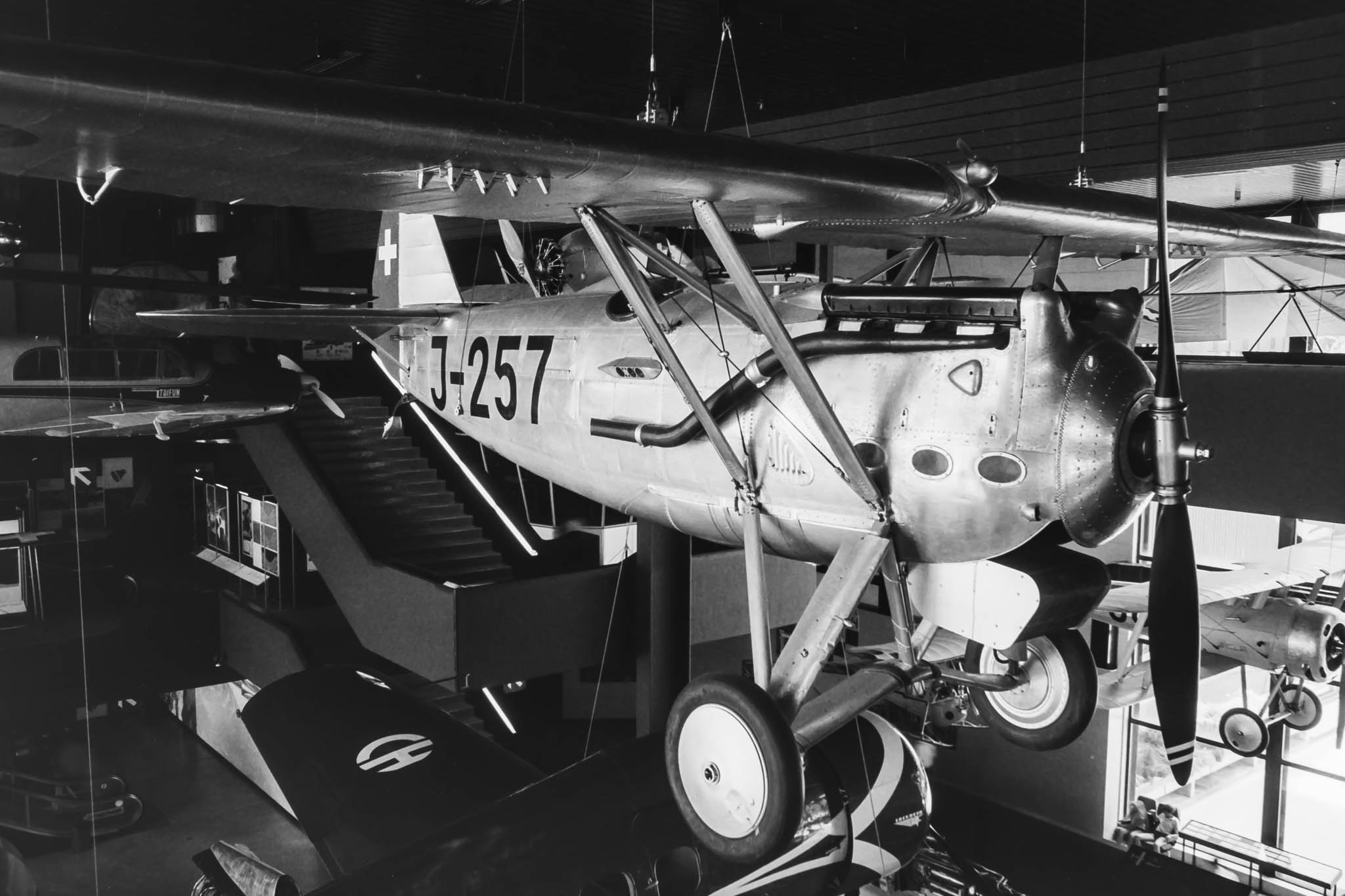 |
| Dewoitine D.27 (J-257) ex Swiss Air Force, later moved to the Flieger Flab Museum at Dubendorf. |
Left to right:
Bücker Bü133c Jungmeister (U-60) The Bü 133 was built for the Lufwaffe as an advanced trainer it was based on the Bücker Bü 131 Jungmann two-seat basic trainer which first flew in 1935. Six Bü 133 (starting with serial U-51) were purchased from Germany and another 50 were built under licence by Dornier for the Swiss Air Force which operated them until 1968.
Comte AC-4 Gentleman (HB-KIL). The Comte AC-4 Gentleman was designed in 1927 by Swiss company Flugzeugbau A. Comte as a two-seat sport or training aircraft. Swissair operated a single AC-4 Gentleman, mainly between Zurich and Lucerne. The example on display is one of 13 built by Alfred Comte.
North American P-51D Mustang (J-2113 previously 44-73349) now at the Flieger Flab Museum at Dubendorf.
EKW C-35 (C-180) Swiss two-seat reconnaissance biplane aircraft built in the 1930s by the Swiss Federal Construction Works at Thun. It is now on display at the Flieger Flab Museum at Dubendorf. |
